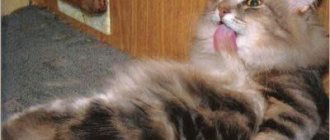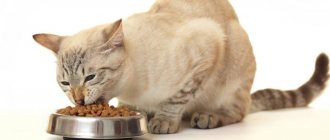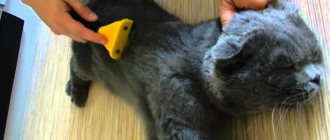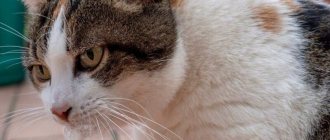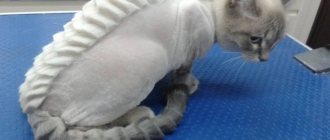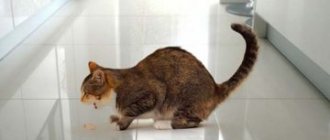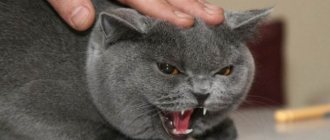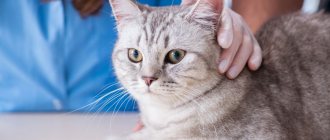Warning
: Invalid argument supplied for foreach() in
/home/shatkov/ourkoshki.ru/www/wp-content/plugins/custom-blocks/custom-blocks.php
on line People are accustomed to considering vomiting and nausea a sign of dysfunction of the digestive system. In cats, everything happens a little differently, and in some cases it is even considered a normal physiological process. Due to their natural cleanliness, cute fluffies constantly lick their fur coat, at the same time swallowing a certain amount of their fur.
This is one of the causes of the gag reflex, which should not cause undue concern. But there are other situations in which vomiting can become a symptom of a dangerous disease. We will look at these and other reasons in our article.
Why does my cat vomit white foam?
Vomiting in an animal is a kind of defensive reaction to the entry of chemical irritants, foreign objects and pathogenic bacteria into the body. A cat vomiting white foam may indicate a malfunction of the biliary system. During the digestion of food in the stomach and its entry into the intestines, the secretion of mucus does not stop, the excess amount of which turns into white bubbles upon contact with air. If in this case the foam has a uniform consistency and nothing is present in it, there is no danger to the cat’s body.
[custom_ads_shortcode1]
How to treat and diagnose a cat's vomiting white foam?
The veterinarian will definitely conduct a visual examination and palpation of the cat’s abdominal cavity. Since there are many reasons that provoke vomiting, additional laboratory examinations - blood tests, general and biochemical urine tests. They allow you to assess the condition of internal organs, as well as confirm or exclude feline distemper.
To exclude
panleukopenia and giardiasis, it will be necessary to conduct a microbiological examination of stool.
An abdominal x-ray is used to identify foreign bodies in the gastrointestinal tract, tumors, intestinal obstruction or coprostasis.
Ultrasound allows you to evaluate the structure of the kidneys, intestines, pancreas, intestinal motility and blood flow in the kidneys.
If the veterinarian suspects gastritis , an ulcer or a tumor in the stomach , then gastroscopy . With its help, the mucous membrane of the esophagus and stomach is examined, and a biopsy of the tissues of these organs is performed.
Therapeutic measures if the cat vomits white foam frequently
If your cat has vomited once or twice and remains alert and active, there is no need to worry.
Sometimes cats themselves look for grass to eat it and induce vomiting, thus clearing the stomach of accumulated hair.
In case of a normal stomach upset, the pet
should be stopped feeding, but not limited in drinking.
Short-term fasting for up to 12 hours helps the body cope with disorders on its own.
The next day, the animal is often and little by little fed rice or oatmeal porridge in chicken broth. When the cat does not get better and the vomiting does not stop , but rather intensifies, other symptoms of ill health appear - diarrhea, fever, lethargy, blood in the vomit, etc., put everything aside and seek help from a veterinarian, since self-medication is no longer effective.
The veterinarian can prescribe the following medications and therapeutic measures for your cat:
- if the animal does not eat and the vomiting does not stop, the doctor will prescribe drips with solutions of electrolytes and glucose, which will restore the level of fluid and important elements in the body;
- a foreign body detected in the digestive tract will most likely require surgical removal or the use of a gastroscope;
- gastroprotectors are used to protect the gastric mucosa from damage produced by hydrochloric acid;
- Antibiotics are often prescribed to treat inflammation in the intestines;
- Antiemetics are used to suppress the gag reflex.
Medicines alone are not enough; a special diet is also required
Low in fat and high in fiber, it helps cleanse the body of toxins and improve gastrointestinal motility.
Kittens require special attention
and young animals up to a year old, since they have a small margin of safety and digestive diseases cause more serious consequences in them than in mature, strong cats.
Prevention to prevent your cat from vomiting white foam
If rare, cleansing vomiting is not a pathology that needs to be dealt with, then painful causes of vomiting can and should be prevented. Carrying out preventive measures is easier and cheaper than treatment. And the help of a veterinarian will not be superfluous here either.
- Veterinarians-gastroenterologists recommend to prevent vomiting in cats:
- Attend routine checkups, this is especially important for older cats.
- Carry out scheduled dewormings once a quarter.
- Vaccinate kittens and cats according to the vaccination schedule.
- Feed your pet healthy food without homemade delicacies.
- Make sure that the cat does not take or swallow small and dangerous objects: toys, threads, needles, foam rubber, bones, etc.
- Brush your long-haired cat often so that less hair gets into its stomach and intestines.
- Exclude raw meat, fish, and offal from food - a source of infection with parasites and protozoa.
The veterinary will help you cope with any digestive problems of mustachioed pets. If treated early, your pet can be back on its feet in a matter of days. Don’t risk his health - call the center for a consultation with a veterinarian, which, by the way, is completely free. If necessary (no time, no transport, late hour), you can call our doctor at home at a time that suits you, around the clock.
We respond to an average of 800 calls per month, which proves that veterinary care at home is necessary and important for our clients, especially in urban living conditions. After an appointment at home, the doctor stays in touch with you and monitors the recovery process, prescribing tests, changing the treatment regimen, diet, and so on, as long as necessary. You can find out prices and services on the website or by calling us. Call us and we will be happy to answer all your questions!
Causes of vomiting in kittens
The kitten vomits white foam in the following cases:
- A sharp transition from one diet to another (for example, the baby has just been weaned from his mother and has been fed full-fledged “adult” food, and his stomach has not yet learned to digest natural food or feed).
- Poor quality, unhealthy food (fatty, fried, salted, smoked, stale food and cheap low-quality food cause a negative reaction and rejection in the kitten).
- Overeating and eating too large pieces of food.
- Getting a large amount of hair into the stomach (with frequent and active licking).
- Accidental ingestion of foreign objects (candy wrapper, toy part, Christmas tree tinsel and other inedible things).
- Poisoning with a substance of chemical origin (medicine, dishwashing liquid, cosmetics, litter, alcohol).
- Possible consequences of vaccination.
- Liver problems, pancreatitis, or triaditis, any infectious diseases.
If the baby vomits, you need to try to find out the exact reason and show the animal to the doctor.
[custom_ads_shortcode2]
[custom_ads_shortcode3]
Vomiting in cats
An adult cat vomits for the same reasons as a small kitten. If this happens rarely, there is no need to worry, but if the animal vomits for quite a long time and this condition is periodic, you should immediately contact a veterinarian. The doctor will conduct an examination and establish the correct diagnosis. The inspection consists of the following stages:
- Determining the frequency and duration of vomiting;
- clarification of information about nutrition and the possible ingestion of dangerous objects and substances into the stomach;
- analysis of the type and consistency of vomit, clarifying when the cat vomited for the first time
- analysis of the cat’s general condition, appetite;
- questions to the owner about other chronic or infectious diseases already known to the owner.
Something else interesting: Wounds in cats
If the animal has vomited only once, the vomit is not profuse, has a white or slightly yellowish color, and there are hairballs in it, monitor your animal for 24 hours. Typically, this type of discomfort should go away on its own. The situation becomes serious if the cat feels sick and vomits for more than a day. In this case, the body quickly becomes dehydrated, which can lead to more serious consequences. If at the same time the cat looks sick, lethargic, does not go to the toilet and does not allow his stomach to be touched, a visit to the veterinarian cannot be postponed.
A cat that has not eaten for more than two days and is vomiting periodically may be seriously ill. In such cases, you should take a general blood test, urine test, x-ray and ultrasound of the kidneys and abdominal cavity. Such prolonged vomiting is not physiological in nature and may be a sign of severe food poisoning, plague infection, exacerbation of one of the chronic diseases or panleukopenia.
Important! If hair regurgitation occurs regularly, this indicates improper functioning of the digestive system. This pathology is a consequence of problems with the bile ducts, inflammatory processes of the rectum and pancreatitis.
[custom_ads_shortcode1]
Natural Causes of White Vomit
The gag reflex and the secretion of white foam in animals are an important defense mechanism against environmental factors, allowing them to get rid of unnecessary and harmful contents of their stomach.
A cat vomiting white foam – causes:
- Wool . Cats belong to the category of clean animals that often lick their skin and keep it neat. Over time, a whole ball of fur accumulates in the animal’s stomach, which provokes foam from the mouth and white vomit. It is recommended that pets with long and thick hair be given special medications (grass, tablets and pastes) to improve the removal of the hairball from the stomach, otherwise health problems cannot be avoided.
- Feed _ It happens that a cat vomits white foam after he has eaten dry food. This happens because dry food swells greatly in the stomach, and it rejects excess food. Dry feeding for cats always requires clean drinking water nearby.
- Hunger . The cat breed is sensitive to lack of food; their digestive system will synthesize all the necessary enzymes and secretions, even if the cat has been hungry for several days. The hydrochloric acid of the gastric juice irritates the mucous membranes of the organs and digestive sections - hence the white foam with vomiting. Your pet shouldn't go hungry!
- Binge eating . Some pets are unable to control the amount of food they eat, so they overeat, then white foam leaves the mouth and a gag reflex occurs due to the excess of undigested food. Swallowing food too quickly without sufficiently chewing chunks and lumps of food can also result in it being rejected from the stomach through the mouth and nose. A distinctive feature of this condition is the presence of pieces of food, white foam and mucus in the vomit.
- Foreign body . Cats are curious and need to taste everything. A pet can swallow any household item, followed by white foam and active vomiting, after which the animal becomes the same – cheerful, affectionate and playful. It’s worse if the pet has eaten or licked medications, chemicals, poisonous or poisonous substances, then unpleasant consequences cannot be avoided.
- Pregnancy . Cats, like women, always feel sick and vomit in the early stages of pregnancy. This is the result of changes in hormonal levels, which is considered normal, and therefore should not cause unnecessary concern to the owners. The gag reflex with white foam can also occur in the last stage of pregnancy, this is due to the voluminous uterus and its pressure on the cat’s digestive organs.
- In heat . Every living creature has an instinct for procreation, and the cat breed is no exception. On average, they come into heat 3-4 times a year, and the animal is distinguished by special behavior. The estrus stage of estrus may be accompanied by nausea, foaming and white vomit.
- Medicines . A pet may react with white foam after taking medications that are prescribed to animals by veterinarians during illnesses and for their prevention. White foam may occur in your pet after taking strong antibiotics. White vomiting can also be caused by Duphalac, which is recommended for animals as a laxative for constipation. A cat may also vomit with white foam from deworming medications.
- Stress . Poor health and nausea can occur against the background of an imbalance in the pet’s psychological state. Fear, changes in living conditions, excitement and other stressful situations in an animal can lead to nausea and vomiting.
© shutterstock
Attention! To avoid the nausea reflex from dry food, alternate it with natural food, periodically change the type of food and always leave fresh water for your pet.
Types of vomiting
In most cases, the cause of vomiting can be determined by the consistency and type of vomit.
- If an animal vomits yellow foam, this means that during the digestion of food a certain amount of bile enters the cat’s stomach. This often happens with gastritis, colitis, and problems with the biliary tract. Against the background of bile secretion, the liver is cleansed of harmful microorganisms and toxic substances. Thus, a cat can vomit due to calcivirosis, feline distemper, a change in food, or a small foreign object entering the stomach.
- The animal vomits clear liquid or saliva due to a rather dangerous disease - distemper. At the same time, the cat can also vomit yellow liquid or foam, which does not contain undigested food and hairballs. With each subsequent urge, the cat gets worse, he becomes lethargic and apathetic, and hides in a dark place. When a cat vomits a clear, almost colorless liquid, its body loses water, which leads to rapid dehydration.
- It happens that a cat may vomit right after eating. The reason for this is intestinal parasites, which are found even in domestic cats. Also, a cat may regurgitate undigested food that is not absorbed by its body. This condition can manifest itself with intestinal obstruction, gastritis, colitis, hepatitis, or pancreatitis. An animal may regurgitate food it has just eaten due to a certain amount of hair that has accumulated in its stomach or due to overeating.
- If helminths live in a cat's body, the cat may well vomit worms. In such a situation, you should take preventive measures, limit your pet’s contact with people and make a visit to the veterinarian. You can start taking antiparasitic drugs only after passing a stool test, which determines the type of worms living in the animal’s body. When treating a cat for worms, clean and fresh water should always be present in its drinking bowl.
Something else interesting: Roundworms in cats
[custom_ads_shortcode2]
[custom_ads_shortcode3]
What to do if a cat vomits?
If the gag reflex occurred once, the release of vomit quickly ended, and symptoms such as temperature fluctuations, diarrhea, weakness and lethargy are absent, try to alleviate the cat’s suffering on your own. In case of poisoning, the animal should stop feeding; it is better to provide it with a regular drinking regimen. You can give your cat a weak solution of potassium permanganate, which has a bactericidal effect.
The maximum “duration” of fasting should not exceed 12 hours. About once every two hours you need to give your fluffy water or a weak solution of Smecta.
After your general condition improves, you can gradually return to your previous diet. You can give small portions of boiled chicken meat, rice water, liquid chicken broth or specialized medicinal food. After two or three days, you can transfer your pet from a gentle diet to a regular one.
[custom_ads_shortcode1]
In what cases do we run to the doctor?
This should be done in most situations. If:
- The animal vomits foam or liquid for 3-4 hours;
- vomit is white or yellow, with blood visible in it;
- the potential furry patient vomits for a long time and refuses to eat or drink.
- In addition to the main problem, the cat developed diarrhea, the nose became dry and hot, weakness appeared, the temperature rose and convulsions began.
In such cases, you should not act at your own discretion; you need to contact a veterinary clinic as soon as possible, where the poor fluffy:
- They will make a diagnosis;
- will prescribe antiemetic drugs;
- They will give you a pain reliever that will help eliminate the spasm;
- will prescribe gastroprotectors necessary for the gastric mucosa;
- will prevent dehydration and replenish the lack of fluid with special solutions;
- If necessary, antibiotics and anthelmintic drugs will be prescribed.
The complex of actions described above will help minimize the negative consequences of vomiting and prevent its occurrence in the future.
To prevent more serious diseases, the symptom of which is vomiting, you need to monitor your pet’s diet, get all the necessary vaccinations and carry out regular preventive maintenance against fleas, ticks and helminths. All these measures will help maintain the health of your cat.
Vomiting is considered a sign of a digestive system disorder, but in cats this process may be normal. In some cases, animals specifically eat grass. This triggers a gag reflex, which helps clear the stomach.
If your cat vomits white foam rarely, there is no need to worry. However, if this happens constantly, you should take your pet to the vet, as vomiting can be a symptom of a serious illness.
[custom_ads_shortcode2]
Cat vomits white due to illness
Please note! Symptoms of vomiting in a kitten can indicate a hundred different diseases and abnormalities. It is possible to cure a pet only if the root cause of the gag reflex is accurately established, so you cannot do without a good veterinarian.
White vomiting, as one of the symptoms, is associated with many feline pathologies and diseases:
© shutterstock
If a kitten vomits while he is eating, and the gag reflex occurs mixed with belching and white foam, then this indicates muscle weakness of the sphincter located between the esophagus and the stomach. The bolus of food does not pass into the gastric region and is regurgitated by the animal.
The right solution is to feed your pet finely ground food fractionally (5-6 times a day) and in small doses. As the kitten gets stronger, its esophageal muscle will return to normal.
Causes of vomiting in cats and kittens
Vomiting white foam in cats and kittens can be a protective reaction to the entry of pathogenic bacteria and irritating substances into the digestive system.
This symptom may appear if the animal has eaten something wrong. Pay attention to the vomit. Don't worry if the white foam is a smooth consistency. This may mean a temporary disruption to the digestive system.
Let's look at why a kitten may vomit white foam:
- Overeating, feeding too large pieces of food.
- Hunger. If an animal does not eat for a long enough time, gastric juice begins to irritate the mucous membranes of the digestive organs. As a result, the kitten vomits white foam.
- Too abrupt a transition from one diet to another.
- Feeding food that is harmful to the kitten (fatty, fried, smoked).
- Stale food, ready-made economy class rations.
- Eating inedible objects.
- Poisoning with chemicals (household chemicals, medications, alcohol).
- Consequences of vaccination.
- Inflammatory diseases of the gastrointestinal tract. Symptoms appear immediately after feeding. The kitten first burps, then vomits. If severe diarrhea is added to vomiting, the animal may die.
- Kidney diseases. Vomiting is accompanied by thirst and difficulty urinating.
- Infectious diseases. The most dangerous are feline distemper and panleukopenia, which can be fatal. The kitten vomits white or yellowish foam, attacks occur quite often.
- Respiratory diseases of viral, bacterial etiology. In this case, vomiting is accompanied by a cough, and a small amount of blood is present in the foam.
- Inflammatory diseases of the adrenal glands. The result is a disruption of the normal process of cortisone synthesis, which is accompanied by vomiting, diarrhea, and muscle weakness.
- Worm infestation. Vomiting is caused by toxins that are formed during the life of parasites.
A possible cause of vomiting may be a large amount of fur entering the stomach if the animal licks itself frequently. This process is typical for long-haired animals.
Opinion and advice on treating vomiting in a cat from a veterinarian
Most experts believe that nausea in pets is usually a consequence of improper care and nutrition.
If the animal's condition worsens, it is recommended:
- Analyze your diet. Poor or low-quality food in most cases leads to diseases of the gastrointestinal tract. You need to choose the right diet and organize fractional drinking.
- Measure body temperature. In case of infection or inflammation it will rise, in case of poisoning it will decrease.
- Analyze the composition and smell of vomit. This may indicate a possible cause for the worsening condition and may also help your veterinarian make a diagnosis.
- If vomiting occurs in small kittens, you should immediately consult a doctor. Their body is not yet strong, and any deterioration in health can lead to death.
- Do not self-medicate. It may be wrong and have dire consequences.
What to do if your cat is vomiting?
So, what should you do if your cat is vomiting white foam? Observe your pet for 24 hours. If your cat vomits but is still acting normally, signs of discomfort may disappear the next day.
If you suspect poisoning or an exacerbation of gastrointestinal diseases, you can try to help the cat by giving it a fasting day. This will restore the functioning of the damaged organ.
The next day, the animal’s condition should return to normal and the vomiting should stop. On the first day after the fasting day, give your cat rice cooked in chicken broth. Feed your pet more often (up to 6 times a day), in small portions.
In subsequent days, reduce the number of feedings and increase the amount of food. Then gradually transition the cat to a regular diet.
If the vomiting was caused by a common stomach upset, give your pet a mint infusion. Pour 1 teaspoon of herb into 1 cup of boiling water and leave until cool. The drink should be warm.
Give your cat 1 tablespoon immediately after vomiting.
Treatment and prevention
If a pet's health worsens, the owner should not treat it themselves. In this case, the risk of complications as a result of incorrectly selected methods and means increases.
An experienced specialist can accurately diagnose and prescribe therapy, taking into account the animal’s condition and the severity of the disease.
Providing first aid to a cat who is vomiting
It is useful for the owner to know what first aid is for a pet.
But any assistance actions can only be carried out under the following conditions:
- the cat looks healthy;
- nausea recurred once;
- there are no additional signs of deterioration in health.
Help may include the following:
- Do not give the animal food or water. Fasting for 24 hours will allow the body to rest and regain strength. To quench your thirst, you can give a piece of ice to lick.
- After a day, you can start feeding him food with a slimy consistency.
- A return to regular food occurs after a couple of days.
- If you suspect poisoning or ingestion of a foreign body, you should induce a vomiting attack. In case of poisoning, such vomiting will only help in the first couple of hours. This will stop the action of toxins, but if a lot of time has passed, they have already entered the bloodstream.
- When worms appear, an antihelminthic drug must be given.
No owner is immune from the deterioration of a pet's condition.
If your health deteriorates significantly, you should immediately contact your veterinarian.
Following simple rules of care will help reduce the likelihood of vomiting attacks:
- feed only fresh food;
- give food in small portions in several doses;
- give preventive vaccinations;
- give antihelminthic drugs annually;
- pets with long hair should be combed with special brushes and given medications to improve the natural elimination of hairballs from the body;
- remove all small objects from reach;
- Periodically visit the veterinarian for a preventive examination.
When medical help is urgently needed
If your health deteriorates significantly, you should immediately contact your veterinarian.
Dangerous symptoms may include the following:
- attacks of nausea continue for several days;
- vomiting appears several times a day;
- foreign impurities appear (bile, foam, blood);
- attacks of nausea appear even between meals;
- there are other symptoms - increased or decreased body temperature, diarrhea, discharge from the nose or eyes, weakness.
Be sure to read:
A cat often burps: causes, symptoms, what to do when vomiting after eating, prevention, what not to do
The doctor examines the animal and asks the owner about all the details of the deterioration of his health condition. Detailed answers allow the specialist to make a diagnosis and prescribe treatment.
In some cases, additional examinations may be performed - ultrasound, gastroscopy, blood tests or x-rays.
Diseases of the gastrointestinal tract and genitourinary system
Most experts believe that the appearance of nausea in pets, as a rule, is a consequence of improper care and nutrition.
If a pet is diagnosed with gastrointestinal pathologies, diet and medications are used.
Depending on the cause of vomiting, the following may be used:
- rehydration preparations to restore the body’s water balance;
- antiemetics to improve well-being;
- antibiotics to fight bacteria;
- sorbents for cleansing of toxins;
- phytotherapy.
In severe cases, surgery is used. With the help of operations, large bezoars, kidney stones, foreign objects are removed, and large injuries to internal organs are sutured.
In what cases should you contact a veterinarian?
The situation becomes more complicated when the pet feels sick and vomits for more than a day, it becomes weak and lethargic and looks sick. If the cat does not go to the toilet or does not allow his stomach to be touched, you should urgently contact a veterinarian. Other reasons to contact a specialist:
- After a starvation diet, the pet’s condition does not improve; he often vomits (several times an hour).
- If your cat doesn't eat anything all day. In this case, foamy vomit is most likely a sign of a serious illness.
- Vomiting is accompanied by severe thirst, and the cat does not go to the litter box. This indicates kidney pathology.
- Diarrhea, fever (above 38-39 ºС).
- Cramps. The symptom indicates damage to the central nervous system.
- Bloody discharge can be seen in the vomit.
- If your cat regularly spits up fur, his digestive system is not working properly. Your pet may have diseases of the gallbladder, pancreas or rectum.
Vomiting that does not stop for more than a day leads to dehydration. This condition poses a serious threat to life. The following sign indicates severe dehydration with prolonged vomiting: lift an area of skin with your fingers and release it, it will slowly return to its original shape.
To prevent the death of the animal, you should not self-medicate. Be sure to show your cat to a veterinarian, who will determine the cause of vomiting and provide adequate therapy.
[custom_ads_shortcode2]
Symptoms signaling disease
Vomiting is a symptom of many pet illnesses . The nature of the masses and their composition differs depending on the type of pathology.
Appearance of white foam
Vomiting is a sign of many diseases in pets.
The appearance of white foam is not always dangerous. This phenomenon is often observed in hungry pets. Long intervals between meals contribute to the fact that the empty stomach begins to produce mucus, which suppresses gastric juice. A mixture of juice, mucus and air forms such foam.
If white foam appears often enough, then there is a high probability of stomach disease.
Vomit with bile
Bile is a yellow-colored impurity in vomit. It causes nausea due to stomach irritation. In isolated cases, the appearance of bile indicates high fat content of food or swallowing large pieces.
Frequent vomiting with bile signals the development of diseases of the liver, pancreas or intestines.
Vomiting food
The appearance of masses of undigested food indicates that the pet is overeating or swallowing too large pieces. The attack appears once.
If this phenomenon is repeated frequently, then there is a likely risk of developing stomach diseases (ulcers, gastritis or colitis). A sick stomach cannot cope with the digestion of food and becomes empty.
Blood impurities
The appearance of blood is a dangerous sign and requires immediate medical attention.
Be sure to read:
A cat has diarrhea and vomiting: what to do at home, reasons, what can be given, what to feed
The appearance of masses of undigested food indicates that the pet is overeating or swallowing too large pieces
In this case, there may be two options:
- Impurities of a bright scarlet hue indicate the presence of open wounds in the oral cavity or esophagus.
- Brown impurities appear when there are wounds in the stomach or intestines.
Factors that cause the appearance of wounds may include the ingress of foreign objects, the development of an ulcer or tumor, liver or intestinal diseases.
What to do if your cat is vomiting yellow foam?
If a cat vomits yellow foam, it means that bile has entered its stomach. The cause is diseases of the gastrointestinal tract (gastritis, colitis), biliary tract.
Yellowish vomiting in a cat can occur due to calcivirosis, a sudden change in diet, or a foreign body entering the stomach. If your pet has eaten stale or low-quality food, the load on the liver increases. In this case, vomiting of yellow liquid may also occur.
If you suspect that an inedible object or poor-quality food has entered the stomach, you need to provoke vomiting. Give the animal a saline solution. To prepare it, stir 1 tablespoon of salt in 1 glass of warm water. Drink the solution until the cat begins to vomit.
If vomiting yellow foam was caused by poisoning, give your pet activated charcoal. In case of exacerbations of gastrointestinal diseases, exclude rough, fatty foods from the animal’s diet. In severe cases, when vomiting with yellow foam was caused by infections, the cat should be taken to the veterinarian. In this case, you need to make droppers with saline solutions and medications.
Digestive problems that arise in pets quite often worry their owners. When your beloved cat begins to vomit white foam, it causes a completely justified feeling of anxiety. It is important to determine how great the degree of danger is and to be able to provide first aid if necessary.
[custom_ads_shortcode1]
What does vomiting white foam mean?
Vomiting in cats occurs spontaneously. Poor quality food, excess food or liquid, foreign body, chemicals can become a signal for the gag reflex. The animal’s brain also activates vomiting due to more serious reasons - gastrointestinal pathologies, increased intracranial pressure, exposure to external factors, poisoning or the presence of worms.
Veterinarians consider white vomiting a universal symptom and recognize many diseases by it. Cat breeders should know about the causes of vomiting foam and white liquid, and be able to respond promptly and competently to what is happening.
The mechanism of the gastrointestinal tract of cats is similar to that of humans: the bolus of food enters the stomach and is digested there in a few hours. Next, the gastric contents follow into the intestines. In this case, a minimal amount of gastric juice and special mucus remain in the stomach to protect the walls from corrosion. Protective mucus consists of polysaccharides and proteins, which react with oxygen in the air to form a white foam. Therefore, if a cat vomits white foam, then this most likely happened on an empty stomach and without any aggravating factors.
© shutterstock
Why does a cat vomit white foam?
The gag reflex in representatives of the cat family is often a protective reaction to the ingress of a foreign object, irritating substances or pathogenic bacteria. In such cases there is no cause for concern. It’s another matter when vomiting is a sign of a serious pathology that requires immediate treatment.
It is almost impossible to independently determine what exactly caused the regurgitation of foamy liquid, so consulting a veterinarian will never be superfluous. The most common causes of vomiting:
- The most dangerous diseases are panleukopenia and feline distemper. In advanced cases, they can be fatal. Vomiting with white or yellowish foam, in which there are no food particles, occurs frequently, without bringing relief to the animal.
- An infectious respiratory disease when vomiting is accompanied by coughing, and a small amount of blood is present in the regurgitated foam.
- Inflammatory processes in the gastrointestinal tract. The most harmless pathology among them is heartburn. Symptoms occur immediately after feeding. Enteritis is a deadly disease when a cat's vomiting of white foam is accompanied by prolonged diarrhea.
- Inflammation of the adrenal glands. Muscle weakness is noted, the animal becomes lethargic, and the sugar level decreases. Without immediate assistance, the cat may die.
- Poor diet is one of the most common causes of vomiting. When you overeat, your body begins to resist the large amount of food you eat. High sensitivity in cats is also observed when there is a lack of food. Foamy vomiting occurs if the animal is not fed for a long time, which leads to the accumulation of hydrochloric acid, which irritates the stomach walls. A starvation diet for a cat should not last more than a day.
- Accumulation of hair in the stomach. This problem is especially relevant for long-haired breeds. When licking, the fur is swallowed inside, forming into dense clumps. Their irritation of the gastric mucosa causes the cat to vomit white foam.
- Worms and other parasites. Toxins formed during their life processes do not have time to be processed. The body responds to intoxication by vomiting, trying to get rid of harmful substances.
- Poisoning. Occurs as a result of the action of medications, household chemicals, poisonous insect bites, and accidental eating of poisonous grass.
A single vomiting with a small amount of foam is not a reason to panic. It is recommended to observe your pet for 24 hours - signs of discomfort may disappear the next day. If the situation worsens, the cat looks sick, there is no appetite, a visit to the doctor is not postponed.
[custom_ads_shortcode2]
Medical nutrition
During therapy, in addition to the use of medications, it is important to put your pet on a therapeutic diet. Do not forget about drinking; to prevent dehydration, it is useful to add a solution of electrolytes to the liquid. The cat may refuse to drink such liquid. If you can’t get something to drink, the animal breaks out and IVs are placed in the hospital. Meals during treatment should consist only of natural products. The menu includes meat baby food, rice, boiled potatoes, chicken, low-fat cottage cheese and kefir. The number of meals is 4-6 times a day. If your cat doesn't eat enough, you need to remove the food. They switch to the usual diet gradually, gradually adding other foods.
First aid
What should you do if your cat is vomiting white foam, but there are no obvious symptoms indicating a serious illness? When your pet’s condition does not cause concern, and you cannot get to the nearest veterinary clinic, you can try to help him with a daily starvation diet. During this time, the digestive system is unloaded, due to which the damaged organ is restored.
The next day, when the condition stabilizes and the vomiting stops, you can gradually give rice cooked in chicken broth. The cat must be fed frequently (up to six times a day), but in small portions. Every day the volume of food is increased, while simultaneously reducing the number of feedings.
For common stomach upset, mint decoction is effective. After brewing and cooling it to 37⁰C, pour one tablespoon into the cat’s mouth immediately after vomiting. If there is a suspicion of accumulation of hairballs in the pet's intestines, the cat is given a teaspoon of oil 3 times a week, adding it to the food. It has a laxative effect, which leads to the cessation of vomiting.
[custom_ads_shortcode3]
When to see a doctor
If vomiting occurs repeatedly, you should not postpone a visit to the veterinarian. In addition, there are a number of accompanying signs indicating the need for urgent medical attention:
- The cat has no interest in food. Together with foamy vomiting, this is a very alarming symptom, raising suspicion of liver lipidosis.
- Intense thirst. When an animal does not move away from a cup of water, there is a high probability of kidney pathology.
- The cat does not urinate for a long time, although he drinks a lot.
- Vomiting occurs very often - up to several times in one hour.
If you notice signs of illness in your cat, you should not wait for a miracle or self-medicate. Vomiting that continues for more than a day can cause dehydration, which poses a serious threat to the pet’s life. Timely professional assistance will help alleviate the animal’s condition and prevent its death.
[custom_ads_shortcode1]




